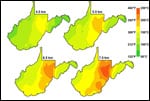A Nov. 12 article on MSNBC cites the research of SMU physiologist and biomechanist Peter Weyand in which he and other scientists found that everyone uses about the same amount of energy when they walk, but short people use more energy over a given distance. The reason: people with shorter legs take more steps to cover the same distance as people with longer legs.
Weyand says the study has clinical applications and weight balance applications. In addition, the military is interested too because metabolic rates influence the physiological status of soldiers in the field, he said.
Also covering the research is UPI, with the story Equation calculates energy cost of walking.
Weyand is an SMU associate professor of applied physiology and biomechanics in the Annette Caldwell Simmons School of Education & Human Development. He lead a team of experts in biomechanics and physiology that conducted experiments on Oscar Pistorius, a South African bilateral amputee track athlete. Pistorius has made headlines trying to qualify for races against runners with intact limbs, including the Olympics.
Excerpt:
By Rachel Rettner
MSNBC
Scientists have come up with a new equation to determine how much energy people actually use while walking.While previous work has conjured many ways to measure the energy cost of walking, the new equation is among the first to account for the impact of body size, taking into account individuals’ height and weight.
The equation has many possible applications. It could be used to design pedometers that, in addition to distance walked, provide an estimate of calories burned, taking into account a person’s body size. The military may also find the equation handy, possibly using it to calculate how much energy soldiers expend — and thus how many calories they will need — while carrying different loads, said study researcher Peter Weyand, of Southern Methodist University in Dallas.
The findings are published today (Nov. 12) in the Journal of Experimental Biology.
Why height and weight matter .Scientists knew that shorter people, including children, use up more energy per pound of their body mass when walking than taller people, but they didn’t know why.
 A Nov. 12 article on
A Nov. 12 article on 


